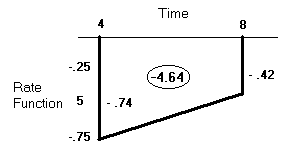
Solution to Problem # 5
What is the average rate of change of the depth function y= .02 t^2-.9t + 12 for the time interval from T=4 to T=12?
This is the first part of the problem. In order to find the rate of change for the depth function, you must substitute the initial time (T=4) into the depth function to find the initial rate, and then take the end time (T=12) and substitute it into the depth function also. This gives you two depths. Subtract the first number (from the T=4 function) from the second number (from the T=12 function). This gives you the change of rate (d'r) of depth. Take this number and divide it by the change in time (d't). This gives you the average rate per second in the depth function.
Substituting (4) for T:
y=.02(4)^2-.9(4) + 12
= 8.72
Substituting (12) for T:
y=.02(12)^2-.9(12) + 12
= 4.08
(T=12)-(T=4)= 4.08-8.42=d'r (Final Depth-Initial Depth)
=-4.64
This is the d'r.
After you have found d'r, then you put it over d't (change in time which is 8 seconds).
=D'r/d't
= -.58 cm/s
This process was to find the average rate per second in the depth function.
Now you you have to find the rate function. The rate function is 2(a)T+B which is 2(.02)(T) -.9.
Now find the value of the rate function at the midpoint at the given time interval.
To do this, you have to add the Times (T's) together and divide by 2, because you want the midpoint of the time intervals.
=(4+12)/2
=(T4+T12)/2
=8
Now substitute 8 into the rate function, and solve. You put 8 into the function because it is the midpoint of the time interval.
=2(.02)(8)-.9
= -.58
This number ( -.58) is the rate at the midpoint of the graph. Notice that it is equal to the average rate per second in the depth function. This is because the midpoint is in the middle of the two rates as is the average.
In making a graph, use the rate function for T=4 and the rate function for T=12 to get your two plots. You use these numbers because you want to find the area between the rate functions.
The Graph:

*Note: We incorporated the same technology that was used in Star Wars.
Using Depth Function, subtract the depth at T=4 from the depth at T=12. Do this because it finds the total change in depth over the period of time.
=4.08-8.72
=-4.64
The answers are once again equal. This is because for the total area graph we are showing the total amount of change in the rate function times 8 seconds (rule function gives change per second, so when multiplying by 8, it gives you the total change over time interval). The depth function also gives the amount of change over the period of 8 seconds.
zcc